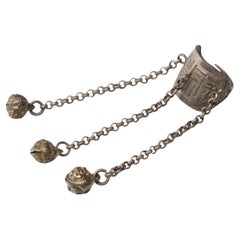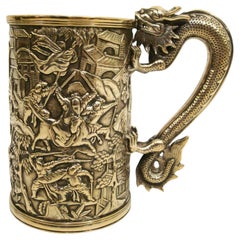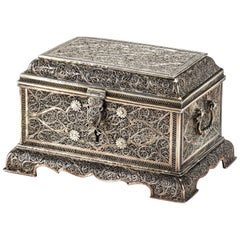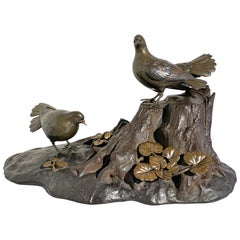Silver Metalwork
Early 20th Century Chinese Qing Silver Metalwork
Silver
19th Century Indian Antique Silver Metalwork
Silver
Mid-19th Century Chinese Chinese Export Antique Silver Metalwork
Silver
Early 20th Century Indian Folk Art Silver Metalwork
Silver, Brass, Copper
18th Century Indian Antique Silver Metalwork
Silver
Late 19th Century Japanese Meiji Antique Silver Metalwork
Bronze, Silver, Copper
Early 20th Century Japanese Meiji Silver Metalwork
Silver, Bronze, Copper
20th Century Japanese Showa Silver Metalwork
Gold, Silver, Copper, Steel
1890s Japanese Meiji Antique Silver Metalwork
Jade, Gold, Silver, Bronze, Enamel
Early 20th Century Philippine Tribal Silver Metalwork
Silver, Bronze
19th Century Indian Other Antique Silver Metalwork
Gold, Silver, Steel
19th Century Egyptian Egyptian Antique Silver Metalwork
Silver, Copper
1890s Chinese Chinese Export Antique Silver Metalwork
Silver
Late 19th Century Chinese Qing Antique Silver Metalwork
Silver
20th Century Tibetan Tibetan Silver Metalwork
Silver
Early 1900s Chinese Chinese Export Antique Silver Metalwork
Silver
Early 20th Century Japanese Meiji Silver Metalwork
Sterling Silver
1910s Japanese Meiji Vintage Silver Metalwork
Silver, Sterling Silver
20th Century Thai Silver Metalwork
Silver
Early 20th Century Chinese Silver Metalwork
Silver
Late 19th Century Chinese Chinese Export Antique Silver Metalwork
Silver
19th Century Korean Other Antique Silver Metalwork
Silver, Iron
Early 1900s Chinese Chinese Export Antique Silver Metalwork
Silver
Late 19th Century Chinese Chinese Export Antique Silver Metalwork
Sterling Silver
19th Century Persian Islamic Antique Silver Metalwork
Silver
1880s Japanese Meiji Antique Silver Metalwork
Silver, Bronze
Early 20th Century Chinese Chinese Export Silver Metalwork
Silver
Early 20th Century Chinese Chinese Export Silver Metalwork
Sterling Silver
1890s Chinese Chinese Export Antique Silver Metalwork
Silver
Early 20th Century Japanese Japonisme Silver Metalwork
Metal, Silver, Enamel
Late 19th Century Chinese Chinese Export Antique Silver Metalwork
Silver
Late 19th Century Indian Antique Silver Metalwork
Silver
Mid-20th Century Laotian Silver Metalwork
Silver
17th Century Indonesian Dutch Colonial Antique Silver Metalwork
Silver
1930s Chinese Art Deco Vintage Silver Metalwork
Sterling Silver
Early 20th Century Indian Anglo Raj Silver Metalwork
Silver
Late 19th Century Chinese Chinese Export Antique Silver Metalwork
Silver
Early 19th Century Chinese Chinese Export Antique Silver Metalwork
Sterling Silver
20th Century Japanese Silver Metalwork
Silver, Sterling Silver
19th Century Korean Other Antique Silver Metalwork
Silver, Copper, Iron
Early 18th Century Indian Islamic Antique Silver Metalwork
Silver
Late 19th Century Indian Other Antique Silver Metalwork
Silver
1890s Chinese Chinese Export Antique Silver Metalwork
Silver
Late 19th Century Chinese Chinese Export Antique Silver Metalwork
Sterling Silver
Late 19th Century Japanese Meiji Antique Silver Metalwork
Gold, Silver, Bronze, Copper
19th Century Japanese Meiji Antique Silver Metalwork
Metal, Gold, Silver, Copper
Late 19th Century Anglo-Japanese Antique Silver Metalwork
Silver, Bronze
19th Century Chinese Chinese Export Antique Silver Metalwork
Silver
1870s Chinese Qing Antique Silver Metalwork
Silver
Early 20th Century Chinese Chinese Export Silver Metalwork
Silver
Early 20th Century Philippine Tribal Silver Metalwork
Silver, Bronze
21st Century and Contemporary Cambodian Other Silver Metalwork
Silver
Early 20th Century Syrian Other Silver Metalwork
Silver, Brass, Copper
Late 19th Century Japanese Antique Silver Metalwork
Metal, Silver, Bronze
Early 20th Century Chinese Chinese Export Silver Metalwork
Silver
Early 20th Century Chinese Silver Metalwork
Silver Plate
Late 19th Century Japanese Meiji Antique Silver Metalwork
Gold, Silver, Bronze, Copper
Early 20th Century Indonesian Art Deco Silver Metalwork
Silver
19th Century Korean Other Antique Silver Metalwork
Silver, Iron, Bronze
Late 19th Century Japanese Meiji Antique Silver Metalwork
Silver, Bronze




